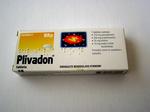I really dislike headaches and although I don’t get them as often as I used to, they are usually not as easy to shake of. That’s why we have several different pills in our home to battle this nuisance. I recently noticed that one of them, Plivadon, has its name stamped in Braille on the box (click for a bigger picture):

It’s great that
Pliva
(Plivadon’s maker) makes its product more accessible to blind people. At the same time, this is also a good example of how difficult good accessibility is.
It’s a common misconception that all blind people either know how to read Braille or can learn how to. In fact, a large part if not majority of them don’t and can’t. The reason for this is that you can learn Braille only if tips of your fingers are sensitive enough and that’s usually the case only for those who were born blind or became blind in their youth.
But blindness can be caused by an accident later in life or by various diseases like diabetes, which means it’s far more common among older people, who through years of working with hands lost the necessary sensitivity in their fingers. They are in such cases forced to cope with their usual methods such as being very organized about where they put things.
Pliva (and other companies) could help them more. They could make the shape and size of the box more unique. They could stamp an easily recognizable pattern on parts of the box, just like they did with Braille. Anything that can make the tactile feedback more unique would probably help.
1
Alas they, as more often than not we, don’t do what they easily could.
Notes:
-
Braille sign on Plivadon’s box is distinguishing enough mark for as long as there isn’t a similarly sized box and a sign at the approximately same position.
↑
